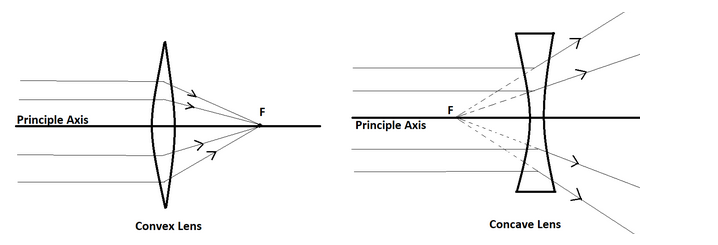
Define principal focus of Convex lens and that of a concave lens.
Answer
585k+ views
Hint: A convex lens also known as a converging lens is thick in the middle and thin at the edges. It converges the light rays coming from a source on the principle focus. A principle focus of a convex lens is defined as the point on the principal axis on which the light rays coming parallel to the principal axis converge after getting refracted from the convex lens.
Complete answer:

A concave lens also known as the diverging lens is a type of lens that is thin in the middle and thicker at the edges. It diverges the rays of light coming parallel to the principal axis. The principal focus of a concave lens is that point on the principal axis on which the rays of light that get diverged after refraction through the lens, when produced backwards, tend to meet. The refracted rays appear to diverge from the Principal Focus of a concave lens.
Additional Information: The distance between the Lens and the principle focus is called the focal length. By convention the measurements on the right side of the lens/mirror are taken positive and the ones on the left side are taken negative. Similarly, the distances above the principle axis are taken as positive and below it are negative.
Note: For a converging lens the rays would converge on the focus after refraction and for a diverging lens the rays would appear to diverge from the principal focus after refraction.
Complete answer:

A concave lens also known as the diverging lens is a type of lens that is thin in the middle and thicker at the edges. It diverges the rays of light coming parallel to the principal axis. The principal focus of a concave lens is that point on the principal axis on which the rays of light that get diverged after refraction through the lens, when produced backwards, tend to meet. The refracted rays appear to diverge from the Principal Focus of a concave lens.
Additional Information: The distance between the Lens and the principle focus is called the focal length. By convention the measurements on the right side of the lens/mirror are taken positive and the ones on the left side are taken negative. Similarly, the distances above the principle axis are taken as positive and below it are negative.
Note: For a converging lens the rays would converge on the focus after refraction and for a diverging lens the rays would appear to diverge from the principal focus after refraction.
Recently Updated Pages
Master Class 12 Economics: Engaging Questions & Answers for Success

Master Class 12 Maths: Engaging Questions & Answers for Success

Master Class 12 Biology: Engaging Questions & Answers for Success

Master Class 12 Physics: Engaging Questions & Answers for Success

Basicity of sulphurous acid and sulphuric acid are

Master Class 12 Business Studies: Engaging Questions & Answers for Success

Trending doubts
What are the major means of transport Explain each class 12 social science CBSE

Which are the Top 10 Largest Countries of the World?

Draw a labelled sketch of the human eye class 12 physics CBSE

How much time does it take to bleed after eating p class 12 biology CBSE

Explain sex determination in humans with line diag class 12 biology CBSE

Differentiate between homogeneous and heterogeneous class 12 chemistry CBSE




